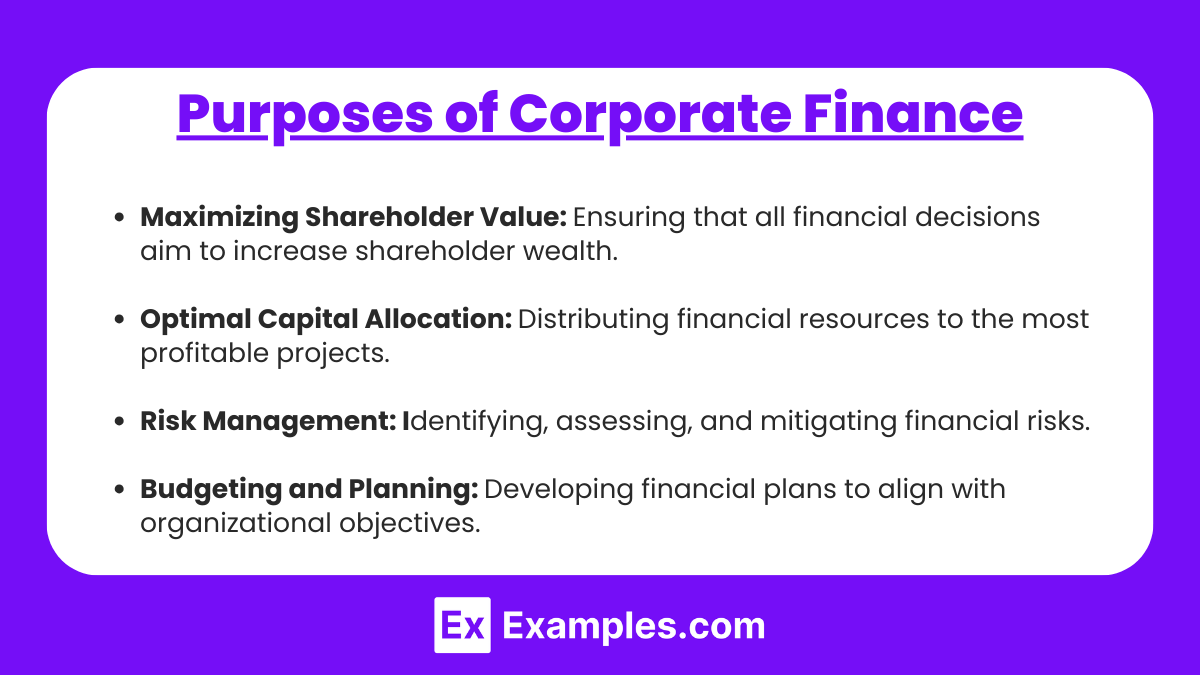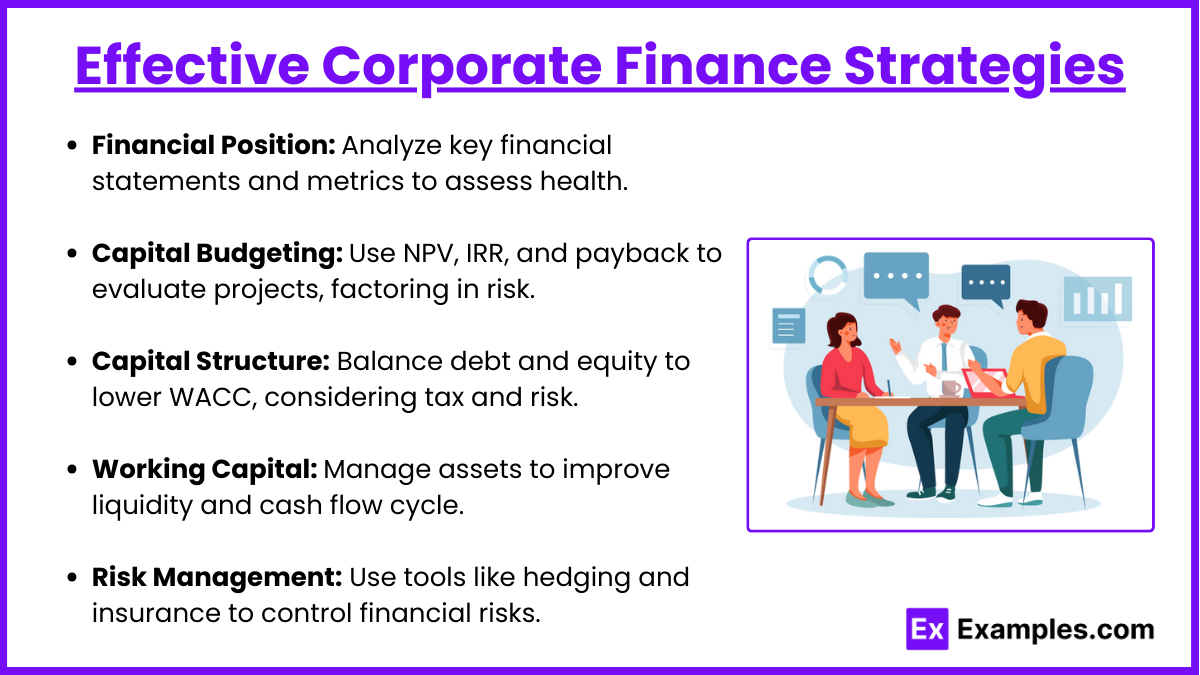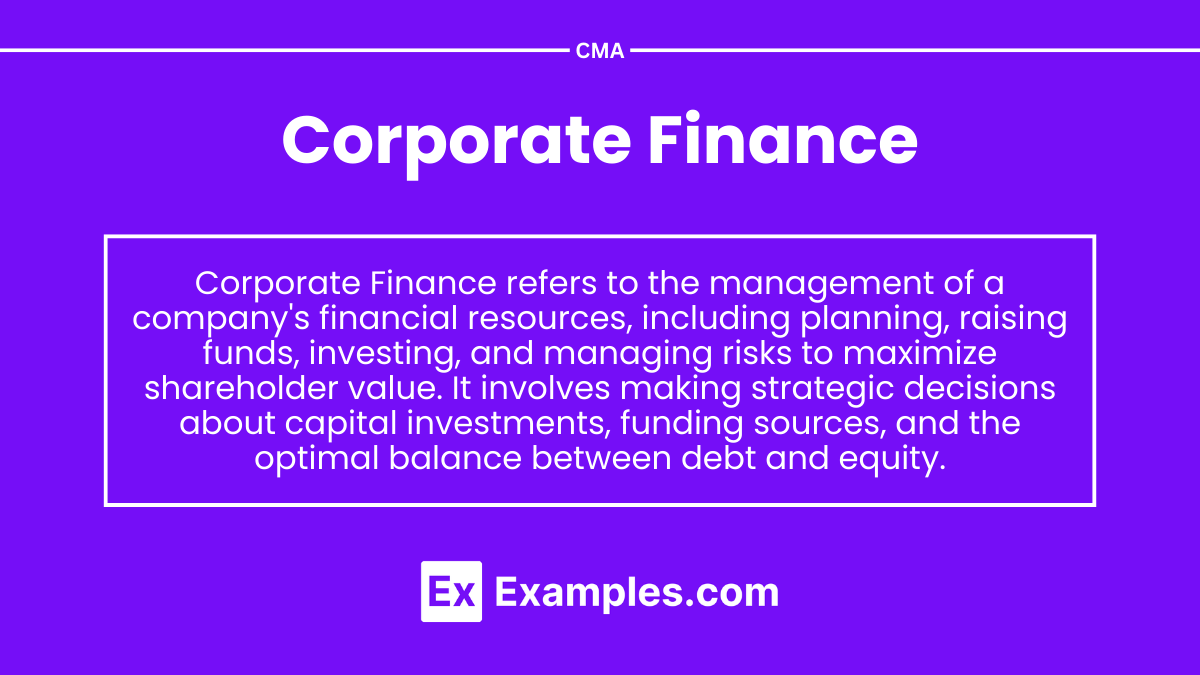Preparing for the CMA requires a comprehensive understanding of Corporate Finance, essential for mastering financial management and decision-making processes. Gaining proficiency in capital budgeting, investment analysis, and financial strategy equips you with vital skills for optimizing resource allocation and enhancing organizational value. Key areas include cost of capital, risk assessment, financial modeling, and the implementation of sound financial policies, all crucial for ensuring effective management of financial resources and supporting sustainable growth, which is critical for success on the CMA exam and effective leadership in finance.
Learning Objectives
In studying “Corporate Finance” for the CMA Exam, you should develop an understanding of the principles governing financial management, investment decision-making, and capital structure. Explore the significance of various financial theories, risk management strategies, and valuation methods in driving organizational success. Evaluate how these elements contribute to effective financial planning and resource allocation. Additionally, grasp how these practices serve as a foundation for ethical financial decision-making and organizational leadership. Apply this knowledge to analyzing investment opportunities, evaluating financial performance, and solving CMA practice questions on capital budgeting, risk assessment, and financial strategy.
Purposes of Corporate Finance

1. Maximizing Shareholder Value
Maximizing shareholder value is a core financial management goal that focuses on increasing the wealth of shareholders. This objective influences all major financial decisions, including investment, financing, and dividend decisions. By strategically aiming to enhance the company’s stock price and distribute sustainable dividends, companies work toward higher returns for shareholders. This approach requires balancing short-term gains with long-term growth, aligning executive decisions with shareholder interests, and ensuring that every financial choice is oriented toward increasing shareholder wealth.
2. Optimal Capital Allocation
Optimal capital allocation is the process of distributing a company’s financial resources to the projects or investments that promise the highest returns. This allocation strategy requires a thorough analysis of potential projects, evaluating their expected profitability and associated risks. By choosing projects that align with the company’s growth objectives and financial capabilities, organizations can ensure that capital is efficiently utilized. Strategic capital allocation not only maximizes potential returns but also minimizes wastage of resources, allowing companies to strengthen their financial position and competitiveness in the market.
3. Risk Management
Risk management in finance involves the systematic identification, assessment, and mitigation of financial risks that could impact the company’s stability and profitability. Financial risks, such as market volatility, credit risks, liquidity risks, and operational risks, can significantly affect a company’s earnings and valuation. Effective risk management involves using tools and frameworks to evaluate the probability and impact of these risks, setting up mitigation strategies like hedging, insurance, and diversification, and developing contingency plans to protect the organization. By actively managing risks, companies safeguard their financial health and improve their resilience in uncertain economic conditions.
4. Budgeting and Planning
Budgeting and planning are critical for aligning a company’s financial resources with its strategic goals. This process involves creating a detailed financial blueprint that allocates resources based on projected revenue and expenses. A robust budgeting framework allows organizations to forecast future cash flows, prioritize spending, and set financial targets. In addition to guiding day-to-day financial decisions, budgeting and planning serve as a foundation for performance measurement, allowing management to assess how well the company is progressing toward its objectives. By continuously refining these plans, organizations can respond to changes in the business environment and maintain a steady path toward their strategic goals.
5. Liquidity Management
Liquidity management focuses on ensuring that the company has enough cash flow to meet its short-term liabilities and operational needs. This involves monitoring cash inflows and outflows, managing working capital, and maintaining sufficient liquid assets. Liquidity is crucial for the smooth operation of day-to-day activities and for covering unexpected expenses without having to liquidate valuable assets or take on excessive debt. Effective liquidity management allows a company to operate flexibly, maintain creditworthiness, and avoid potential financial distress. By optimizing liquidity, companies can ensure they are well-prepared to handle both routine and unforeseen financial obligations.
Types of Corporate Finance

1. Capital Budgeting
Capital budgeting is the process by which companies evaluate potential long-term investments to determine their profitability and strategic fit. This process involves analyzing projects such as new product lines, infrastructure, technology upgrades, or acquisitions. By forecasting expected cash flows, calculating net present value (NPV), internal rate of return (IRR), and payback periods, companies assess the potential returns of a project relative to its risks and cost. Capital budgeting helps organizations allocate resources effectively, prioritizing investments that align with their long-term objectives, enhance competitive advantage, and support sustained growth.
2. Capital Structure
Capital structure refers to the blend of debt and equity that a company uses to finance its operations and growth. The optimal capital structure strikes a balance between risk and return, minimizing the overall cost of capital while maximizing shareholder value. Equity financing, while less risky for the company in terms of repayment obligations, can dilute existing shareholders’ ownership. Debt, on the other hand, is tax-deductible and may offer lower cost but adds financial leverage and increases financial risk. By carefully assessing their capital needs and market conditions, companies can make informed decisions on the ideal mix of debt and equity, ensuring stable funding for both short-term and long-term goals.
3. Working Capital Management
Working capital management focuses on efficiently managing a company’s short-term assets and liabilities to ensure operational continuity and financial health. This includes monitoring cash flow, inventory levels, accounts receivable, and accounts payable. Effective working capital management enables a business to meet its short-term obligations and invest in opportunities without unnecessary financing costs. It’s about striking a balance: too much working capital ties up resources that could be used elsewhere, while too little working capital risks liquidity issues. Companies that excel in working capital management maintain strong liquidity, minimize borrowing costs, and ensure seamless operations even during economic fluctuations.
4. Mergers and Acquisitions (M&A)
Mergers and acquisitions (M&A) are strategic tools for achieving rapid growth, expanding market presence, or gaining access to new technologies and capabilities. In an M&A process, the acquiring company assesses the target’s financials, market position, and operational fit to determine the potential for synergy and long-term value creation. Successful M&A transactions can lead to enhanced market share, cost efficiencies, and competitive advantages. However, the process involves substantial due diligence to identify risks, integration challenges, and cultural compatibility. By analyzing potential deals thoroughly, companies can execute M&A strategies that complement their growth trajectory and improve shareholder value.
5. Dividends and Return Policies
Dividends and return policies concern how a company decides to distribute profits back to its shareholders. This can be done through regular dividend payments, stock repurchases, or reinvesting earnings into the business. The choice depends on factors such as profitability, cash flow, investment opportunities, and shareholder preferences. A stable or gradually increasing dividend can signal financial strength and stability to investors, while stock buybacks can increase share value by reducing supply. Companies with high-growth opportunities may choose to reinvest profits instead of distributing them. A well-considered dividends and return policy not only meets shareholders’ expectations but also strengthens investor confidence and enhances the company’s market reputation.
Effective Corporate Finance Strategies

- Assess Financial Position:
- Analyze the company’s balance sheet, income statement, and cash flow statement to understand financial health.
- Identify key metrics like leverage ratios, liquidity ratios, and profitability ratios.
- Develop Capital Budgeting Plans:
- Use techniques like Net Present Value (NPV), Internal Rate of Return (IRR), and Payback Period to evaluate project feasibility.
- Consider risk-adjusted returns to align with corporate goals.
- Optimize Capital Structure:
- Balance debt and equity to minimize the Weighted Average Cost of Capital (WACC).
- Implement cost-effective funding sources, considering tax benefits and risk factors.
- Enhance Working Capital Efficiency:
- Manage inventory, receivables, and payables to maintain liquidity.
- Use the cash conversion cycle to identify areas for improvement.
- Implement Risk Management Tools:
- Use derivatives, insurance, and hedging strategies to mitigate financial risks.
- Regularly assess financial policies to ensure compliance and sustainability.
Examples
Example 1. Corporate Finance in Strategic Decision-Making
Corporate finance plays a critical role in strategic decision-making within organizations. It provides the framework for assessing financial implications of strategic choices, such as mergers, acquisitions, and divestitures. By evaluating cash flows, risk factors, and the cost of capital, corporate finance helps companies make informed decisions that align with their long-term goals.
Example 2. The Role of Corporate Finance in Capital Structure Optimization
Corporate finance is central to optimizing a company’s capital structure. It involves analyzing debt and equity proportions to achieve an optimal mix that minimizes the cost of capital while maximizing shareholder value. The capital structure must balance financial flexibility, risk, and return, enabling firms to maintain stability and growth.
Example 3. Corporate Finance and Investment Analysis:
Investment analysis is a fundamental aspect of corporate finance, where managers evaluate potential projects to determine their feasibility and profitability. Tools like net present value (NPV), internal rate of return (IRR), and payback period are utilized to assess whether an investment aligns with the company’s financial objectives and enhances overall value.
Example 4. Corporate Finance’s Impact on Risk Management
Managing financial risks is a core function of corporate finance, ensuring that companies can sustain operations even under uncertain conditions. It involves assessing risks related to interest rates, foreign exchange, and credit. Techniques such as hedging, diversification, and insurance are often employed to protect the firm’s assets and financial health.
Example 5. Corporate Finance in Enhancing Shareholder Value
The ultimate goal of corporate finance is to enhance shareholder value by ensuring efficient allocation of resources, effective management of capital, and the pursuit of profitable ventures. It encompasses decisions related to dividend policies, reinvestment strategies, and financial restructuring to maximize returns for investors over the long term.
Practice Questions
Question 1
What is the primary goal of financial management in a corporation?
A) Minimizing costs
B) Maximizing shareholder wealth
C) Ensuring employee satisfaction
D) Increasing market share
Correct Answer: B) Maximizing shareholder wealth
Explanation:
The primary goal of financial management in a corporation is to maximize shareholder wealth, which is typically measured by the stock price of the company. This goal ensures that the company is making financial decisions that enhance the value for its owners, who are the shareholders. While minimizing costs, increasing market share, and ensuring employee satisfaction are important, they are secondary to the main objective of maximizing shareholder value. Efficient financial management includes making investment decisions, financing choices, and dividend policies that contribute to this goal.
Question 2
Which of the following best describes the concept of ‘Capital Budgeting’?
A) The process of managing a company’s working capital
B) The process of deciding how to finance a company’s operations
C) The process of evaluating and selecting long-term investments
D) The process of distributing dividends to shareholders
Correct Answer: C) The process of evaluating and selecting long-term investments
Explanation:
Capital budgeting refers to the process of evaluating and selecting projects or investments that require significant capital and will impact the company’s operations for a long time. It involves determining the potential profitability of investment options, such as expanding production facilities or launching new products. The goal of capital budgeting is to select projects that will maximize the firm’s value over the long term. This differs from managing working capital, which is focused on short-term financial operations, or financing decisions, which involve raising funds.
Question 3
What is the ‘Weighted Average Cost of Capital’ (WACC)?
A) The average return on all projects undertaken by the company
B) The cost of the company’s equity and debt, weighted by their respective proportions
C) The interest rate charged on long-term loans
D) The average amount of dividends paid to shareholders
Correct Answer: B) The cost of the company’s equity and debt, weighted by their respective proportions
Explanation:
The Weighted Average Cost of Capital (WACC) represents the average rate of return that a company must earn on its existing assets to maintain its stock price. It is calculated by taking the cost of each component of the company’s capital structure (debt, equity, and sometimes preferred stock) and weighting it according to the proportion of total capital it represents. WACC is crucial in determining whether an investment is worth pursuing, as a project must generate a return higher than the WACC to add value to the company. It is not the return on all projects, nor is it related to the average amount of dividends.


